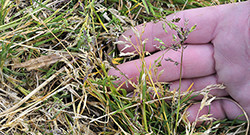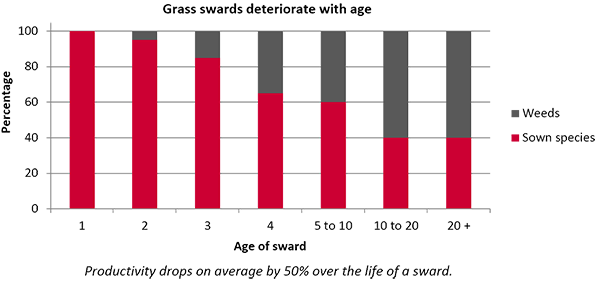
Maintain farm profitability through overseeding
With each passing year, the productivity of a grass sward declines. By year 4, your forage grass could be yielding less than 75% of its initial output as invasive species crowd out the high-yielding, nutricious species in your original seed mixture.
22/02/2016
 Many factors contribute to the drop in yield. For example, bad weather (too wet, too cold, or too dry) reduces the proportion of perennial ryegrass in a sward. Diseases and pests, such as grubs and mice, cause further damage.
Many factors contribute to the drop in yield. For example, bad weather (too wet, too cold, or too dry) reduces the proportion of perennial ryegrass in a sward. Diseases and pests, such as grubs and mice, cause further damage.
Each dead grass plant creates space for invasive species such as rough meadow grass (Poa trivialis) and annual meadow grass (Poa annua).
As the proportion of these unwanted herbs and grasses increases, the profitability of your land declines.

What is the answer? Could overseeding be the best way to maintain yield and keep your fields free of invasive species?
How to overseed?
Numerous experiments show that overseeding combined with the use of a harrow or a disk seeder improves sward performance. An effective overseeding regime helps to close the gaps and prevent the influx of intruder species.
For the best long-term results, you should aim for a good and dense sward. Yet we have already seen that, year by year, all swards become more ragged and patchy. The only way to overcome the problem is through repeated applications of a suitable overseeding mixture.
| Seeding essentials |
| Ragged pastures can be sustainably improved by overseeding or reseeding. Success depends on: moist soils, the best seed, a good sowing method, and careful use of the grassland after overseeding. |
The most cost-effective method is broadcast sowing in conjunction with harrowing and rolling. The technique is easily integrated into your normal springtime routine of post-winter harrowing. An alternative is to overseed in the summer and, in some areas, it is even possible to overseed in the autumn.
Whenever you choose to overseed, the conditions have to be right. You need plenty of moisture in the ground and soil temperatures of 8° to 10°C. In fields used for grazing, you can even assist the process through the subsequent introduction of light grazing animals. When they walk on the sward, they incorporate the seeds into the soil.
Long-term grassland maintenance depends on regular renewal. Through regular overseeding you can achieve a sustained improvement to meadows and pastures. You will create a lasting and harmonious plant stand that continues to provide a high yield and feed value.

